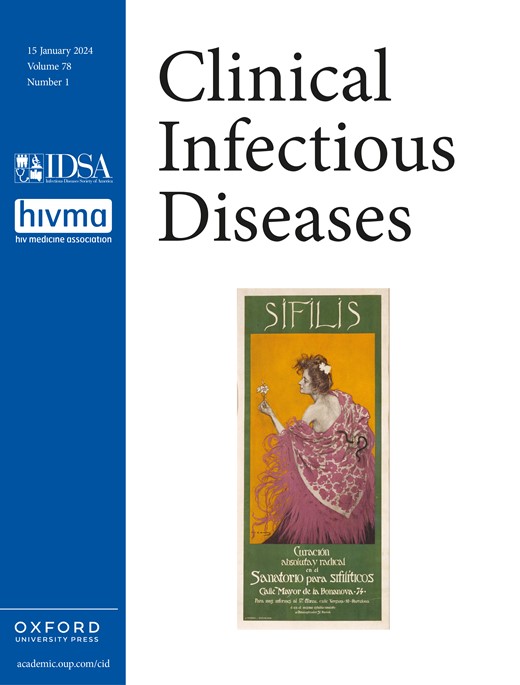Transmitted Human Immunodeficiency Virus Type 1 (HIV-1) Drug Resistance Among Newly Diagnosed Individuals in 31 Provincial-Level Administrative Divisions in China in 2023: A Cross-sectional Survey
IF 8.2
1区 医学
Q1 IMMUNOLOGY
引用次数: 0
Abstract
Background Transmitted drug resistance (TDR) may compromise the effect of antiretroviral therapy (ART), highlighting the necessity for continuous monitoring. Methods The study was conducted across 31 provincial-level administrative divisions of China. Demographic information and blood samples were collected from participants at diagnosis of human immunodeficiency virus (HIV) infection between April and June 2023. TDR and molecular transmission networks were analyzed based on partial pol sequences via the Stanford HIV drug resistance database and HIV-TRACE, respectively. Logistic regression was utilized to identify factors associated with TDR. Results HIV drug resistance genotyping was successfully performed on plasma samples from 6654 individuals. The overall TDR prevalence was 11.4% (95% confidence interval [CI], 10.6%–12.2%). Resistance to nonnucleoside reverse transcriptase inhibitors (NNRTIs), nucleoside reverse transcriptase inhibitors (NRTIs), protease inhibitors (PIs), and integrase strand transfer inhibitors (INSTIs) was 7.9%, 0.8%, 2.4%, and 1.0%, respectively. TDR to efavirenz/nevirapine (EFV/NVP) was 6.5%. According to the surveillance drug resistance mutation list, the prevalence of TDR to total, NNRTIs, NRTIs, PIs, and INSTIs was 8.2%, 6.4%, 1.0%, 0.7%, and 0.4%. Multivariable analysis linked TDR to non-Han ethnicity (adjusted odds ratio [AOR], 1.45 [95% CI, 1.17–1.79]), unknown transmission routes (AOR, 2.56 [95% CI, 1.33–4.90]), and CD4 ≥500 cells/μL (AOR, 1.29 [95% CI, 1.05–1.58]). Higher education (high school or more) reduced TDR odds (AOR, 0.77 vs primary education). Conclusions TDR among people with newly diagnosed HIV in China exceeds 10%, with EFV/NVP TDR >5%. Timely monitoring of TDR and adjustment of ART regimens are essential to mitigate the impact of drug resistance on treatment efficacy.2023年中国31个省级行政区新诊断个体的传染性人类免疫缺陷病毒1型(HIV-1)耐药性:一项横断面调查
背景:传播性耐药(TDR)可能影响抗逆转录病毒治疗(ART)的效果,强调了持续监测的必要性。方法在全国31个省级行政区进行研究。在2023年4月至6月期间,收集了诊断为人类免疫缺陷病毒(HIV)感染的参与者的人口统计信息和血液样本。通过Stanford HIV耐药数据库和HIV- trace分别分析基于部分pol序列的TDR和分子传输网络。采用Logistic回归分析确定与TDR相关的因素。结果对6654例患者进行了HIV耐药基因分型。TDR总体患病率为11.4%(95%可信区间[CI], 10.6%-12.2%)。对非核苷类逆转录酶抑制剂(NNRTIs)、核苷类逆转录酶抑制剂(NRTIs)、蛋白酶抑制剂(pi)和整合酶链转移抑制剂(insts)的耐药率分别为7.9%、0.8%、2.4%和1.0%。依非韦伦/奈韦拉平的TDR (EFV/NVP)为6.5%。根据监测耐药突变清单,TDR在total、nnrti、nrti、pi和insi中的患病率分别为8.2%、6.4%、1.0%、0.7%和0.4%。多变量分析将TDR与非汉族(校正优势比[AOR], 1.45 [95% CI, 1.17-1.79])、未知传播途径(AOR, 2.56 [95% CI, 1.33-4.90])和CD4≥500 cells/μL (AOR, 1.29 [95% CI, 1.05-1.58])联系起来。高等教育(高中或以上)降低了TDR的几率(AOR, 0.77 vs小学教育)。结论中国新诊断HIV感染者TDR比例超过10%,EFV/NVP TDR比例为5%。及时监测TDR和调整抗逆转录病毒治疗方案对于减轻耐药性对治疗效果的影响至关重要。
本文章由计算机程序翻译,如有差异,请以英文原文为准。
求助全文
约1分钟内获得全文
求助全文
来源期刊

Clinical Infectious Diseases
医学-传染病学
CiteScore
25.00
自引率
2.50%
发文量
900
审稿时长
3 months
期刊介绍:
Clinical Infectious Diseases (CID) is dedicated to publishing original research, reviews, guidelines, and perspectives with the potential to reshape clinical practice, providing clinicians with valuable insights for patient care. CID comprehensively addresses the clinical presentation, diagnosis, treatment, and prevention of a wide spectrum of infectious diseases. The journal places a high priority on the assessment of current and innovative treatments, microbiology, immunology, and policies, ensuring relevance to patient care in its commitment to advancing the field of infectious diseases.
 求助内容:
求助内容: 应助结果提醒方式:
应助结果提醒方式:


